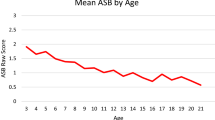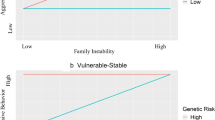Abstract
It has recently been argued that shared environmental influences are moderate, identifiable, and persistent sources of individual differences in most forms of child and adolescent psychopathology, including antisocial behavior. Unfortunately, prior studies examining the stability of shared environmental influences over time were limited by possible passive gene-environment correlations, shared informants effects, and/or common experiences of trauma. The current study sought to address each of these limitations. We examined adolescent self-reported antisocial behavior in a 3.5 year longitudinal sample of 610 biological and adoptive sibling pairs from the Sibling Interaction and Behavior Study (SIBS). Results revealed that 74–81% of shared environmental influences present at time 1 were also present at time 2, whereas most non-shared environmental influences (88–89%) were specific to a particular assessment period. Such results provide an important constructive replication of prior research, strongly suggesting that shared environmental contributions to antisocial behavior are systematic in nature.


Similar content being viewed by others
Notes
To better examine whether our results were impacted by the different symptoms of ASPD assessed as part of CD and AAB, we re-ran our analyses restricting the data to those behaviors that were “common” across the CD and AAB assessments (i.e., CD: stolen without confrontation, lying, fighting, cruelty to others, fighting with a weapon, destroying property, and breaking and entering; AAB: illegal acts, irritability and aggression, impulsivity, and reckless disregard for safety; phenotypic r = .42). Results were notably consistent to those reported above. The non-shared environmental correlation (rE = .50) indicated that most non-shared environmental variance (75%) did not persist over time. By contrast, the shared environmental correlation was estimated to be 1.0 (95% CI = .65–1.0), suggesting that 100% of the shared environmental effects contributing to CD also contributed to AAB. Such results imply that, regardless of the operationalization of CD/AAB, shared environmental influences evidence more stability over time than do non-shared environmental influences.
References
Bartels, M., van den Oord, E. J. C. G., Hudziak, J. J., Rietveld, M. J. H., van Beijsterveldt, C. E. M., & Boomsma, D. I. (2004). Genetic and environmental mechanisms underlying stability and change in problem behaviors at ages 3, 7, 10, and 12. Developmental Psychology, 40, 852–867.
Brengden, M., Boivin, M., Vitaro, F., Bukowski, W. M., Dionne, G., Tremblay, R. E., et al. (2008). Linkages between children’s and their friends’ social and physical aggression: evidence for a gene-environment interaction? Child Development, 79, 13–29.
Buchanan, J. P., McGue, M., Keyes, M. A., & Iacono, W. G. (2009). Are there shared environmental influences on adolescent behavior? Evidence from a study of adoptive siblings. Behavior Genetics 39, 532–540.
Burt, S. A. (2009a). Are there meaningful etiological differences within antisocial behavior? Results of a meta-analysis. Clinical Psychology Review, 29, 163–178.
Burt, S. A. (2009b). Rethinking environmental contributions to child and adolescent psychopathology: a meta-analysis of shared environmental influences. Psychological Bulletin, 135, 608–637.
Burt, S. A. & Donnellan, M. B. (2008). Personality correlates of aggressive and non-aggressive antisocial behavior. Personality and Individual Differences, 44, 53–63.
Burt, S. A., Krueger, R. F., McGue, M., & Iacono, W. G. (2003). Parent-child conflict and the comorbidity among childhood externalizing disorders. Archives of General Psychiatry, 60, 505–513.
Burt, S. A., McGue, M., Iacono, W. G., & Krueger, R. F. (2006). Differential parent-child relationships and adolescent externalizing symptoms: cross-lagged analyses within a twin differences design. Developmental Psychology, 42, 1289–1298.
Burt, S. A., McGue, M., Krueger, R. F., & Iacono, W. G. (2007). Environmental contributions to adolescent delinquency: a fresh look at the shared environment. Journal of Abnormal Child Psychology, 35, 787–800.
Burt, S. A., Barnes, A. R., McGue, M., & Iacono, W. G. (2008). Parental divorce and adolescent delinquency: ruling out the impact of common genes. Developmental Psychology, 44, 1668–1677.
D’Onofrio, B. M., Turkheimer, E., Emery, R. E., Slutske, W. S., Heath, A. C., Madden, P. A. F., et al. (2005). A genetically informed study of marital instability and its association with offspring psychopathology. Journal of Abnormal Psychology, 114, 570–586.
D’Onofrio, B. M., Turkheimer, E., Emery, R. E., Maes, H. H., Silberg, J. L., & Eaves, L. J. (2007). A children of twins study of parental divorce and offspring psychopathology. Journal of Child Psychology and Psychiatry, 48, 667–675.
Eaves, L. J., Silberg, J. L., Meyer, J. M., Maes, H. H., Simonoff, E., Pickles, A., et al. (1997). Genetics and developmental psychopathology: 2. The main effects of genes and environment on behavioral problems in the Virginia twin study of adolescent development. Journal of Child Psychology and Psychiatry, 38, 965–980.
Farrington, D. P. & West, D. J. (1971). A comparison between early delinquents and young aggressives. British Journal of Criminology, 11, 341–358.
Gibson, H. B. (1967). Self-report delinquency among school boys and their attitudes towards police. British Journal of Social and Clinical Psychology, 20, 303–315.
Huizink, A. C., van den Berg, M. P., van der Ende, J., & Verhulst, F. C. (2007). Longitudinal genetic analysis of internalizing and externalizing problem behavior in adopted biologically related and unrelated sibling pairs. Twin Research and Human Genetics, 10, 55–65.
Keyes, M. A., Sharma, A., Elkins, I. J., Iacono, W. G., & McGue, M. (2008). The mental health of US Adolescents adopted in infancy. Archives of Pediatrics & Adolescent Medicine, 162, 419–425.
Little, R. J. A. & Rubin, D. B. (1987). Statistical analysis with missing data. New York: Wiley.
Loeber, R. & Hay, D. (1997). Key issues in the development of aggression and violence from childhood to early adulthood. Annual Review of Psychology, 48, 371–410.
McGue, M., Sharma, A., & Benson, P. (1996). The effect of common rearing on adolescent adjustment: evidence from a U.S. adoption cohort. Developmental Psychology, 32, 604–613.
McGue, M., Keyes, M., Sharma, A., Elkins, I., Legrand, L., Johnson, W., et al. (2007). The environment of adopted and non-adopted youth: evidence of range restriction from the Sibling Interaction and Behavior Study (SIBS). Behavioral Genetics, 37, 449–462.
Moffitt, T. E. (2003). Life-course persistent and adolescence-limited antisocial behavior: A research review and a research agenda. In B. Lahey, T. E. Moffitt & A. Caspi (Eds.), The causes of conduct disorder and serious juvenile delinquency. New York: Guilford.
Neale, M. C., Boker, S. M., Xie, G., Maes, H. H. (2003). Mx: Statistical Modeling. VCU Box 900126, Richmond, VA 23298: Department of Psychiatry, 6th Edition.
Neiderhiser, J. M., Reiss, D., Pedersen, N., Lichtenstein, P., Spotts, E. L., Hansson, K., et al. (2004). Genetic and environmental influences on mothering of adolescents: a comparison of two samples. Developmental Psychology, 40, 335–351.
Neiderhiser, J. M., Reiss, D., & Hetherington, E. M. (2007). The Nonshared Environment in Adolescent Development (NEAD) project: a longitudinal family study of twins and siblings from adolescence to young adulthood. Twin Research and Human Genetics, 10, 74–83.
O’Conner, T. G., McGuire, S., Reiss, D., Hetherington, E. M., & Plomin, R. (1998). Co-occurence of depressive symptoms and antisocial behavior in adolescence: a common genetic liability. Journal of Abnormal Psychology, 107, 27–37.
O’Connor, T. G., Caspi, A., DeFries, J. C., & Plomin, R. (2000). Are associations between parental divorce and children’s adjustment genetically mediated? An adoption study. Developmental Psychology, 36, 429–437.
Pike, A., McGuire, S., Hetherington, E. M., Reiss, D., & Plomin, R. (1996). Family environment and adolescent depressive symptoms and antisocial behavior: a multivariate genetic analysis. Developmental Psychology, 32, 590–603.
Plomin, R. & Asbury, K. (2005). Nature and nurture: Genetic and environmental influences on behavior. The Annals of the American Academy of Political and Social Science, 600, 86–98.
Plomin, R. & Daniels, D. (1987). Why are children in the same family so different from one another? Behavioral and Brain Sciences, 10, 1–60.
Plomin, R., Asbury, K., & Dunn, J. (2001). Why are children from the same family so different? Nonshared environment a decade later. Canadian Journal of Psychiatry, 46, 225–233.
Raftery, A. E. (1995). Bayesian model selection in social research. Sociological Methodology, 25, 111–163.
Reich, W. (2000). Diagnostic interview for children and adolescents (DICA). Journal of the American Academy of Child & Adolescent Psychiatry, 39, 14–15.
Renk, K. (2008). Disorders of conduct in young children: developmental considerations, diagnoses, and other characteristics. Developmental Review, 28, 216–341.
Rhee, S. & Waldman, I. D. (2002). Genetic and environmental influences on antisocial behavior: a meta-analysis of twin and adoption studies. Psychological Bulletin, 128, 490–529.
Rueter, M. A., Keyes, M. A., Iacono, W. G., & McGue, M. (2009). Family interactions in adoptive compared to nonadoptive families. Journal of Family Psychology, 23, 58–66.
Rutter, M., Silberg, J., O’Connor, T. J., & Simonoff, E. (1999). Genetics and child psychiatry: I Advances in quantitative and molecular genetics. Journal of Child Psychology and Psychiatry, 40, 3–18.
Sherman, D. K., McGue, M. K., & Iacono, W. G. (1997). Twin concordance for attention deficit hyperactivity disorder: a comparison of teachers’ and mothers’ reports. American Journal of Psychiatry, 154, 532–535.
Silberg, J., Rutter, M., Meyer, J., Maes, H., Hewitt, J., Simonoff, E., et al. (1996). Genetic and environmental influences on the covariation between hyperactivity and conduct disturbance in juvenile twins. Journal of Child Psychology and Psychiatry, 37, 803–816.
Slutske, W. S., Heath, A. C., Dinwiddie, S. H., Madden, P. A. F., Bucholz, K. K., Dunne, M. P., et al. (1997). Modeling genetic and environmental influences in the etiology of conduct disorder: a study of 2, 682 adult twin pairs. Journal of Abnormal Psychology, 106, 266–279.
Spitzer, R. L., Williams, J. B. W., Gibbon, M., & First, M. B. (1987). Structured clinical interview for DSM-III-R personality disorders. New York: New York State Psychiatric Institute, Biometrics Research Division.
Stoolmiller, M. (1998). Correcting estimates of shared environmental variance for range restriction in adoption studies using a truncated multivariate normal model. Behavior Genetics, 28, 429–441.
Turkheimer, E. & Waldron, M. (2000). Nonshared environment: a theoretical, methodological, and quantitative review. Psychological Bulletin, 126, 78–108.
van der Valk, J. C., Verhulst, F. C., Neale, M. C., & Boomsma, D. I. (1998). Longitudinal genetic analysis of problem behaviors in biologically related and unrelated adoptees. Behavior Genetics, 28(5), 365–380.
Welner, Z., Reich, W., Herjanic, B., Jung, K., & Amado, H. (1987). Reliability, validity, and parent-child agreement studies of the Diagnostic Interview for Children and Adolescents (DICA). Journal of the American Academy of Child & Adolescent Psychiatry, 26, 649–653.
Acknowledgment
This research was funded by USPHS Grants # AA11886 and MH066140.
Author information
Authors and Affiliations
Corresponding author
Rights and permissions
About this article
Cite this article
Burt, S.A., McGue, M. & Iacono, W.G. Environmental Contributions to the Stability of Antisocial Behavior over Time: Are They Shared or Non-shared?. J Abnorm Child Psychol 38, 327–337 (2010). https://doi.org/10.1007/s10802-009-9367-4
Published:
Issue Date:
DOI: https://doi.org/10.1007/s10802-009-9367-4




